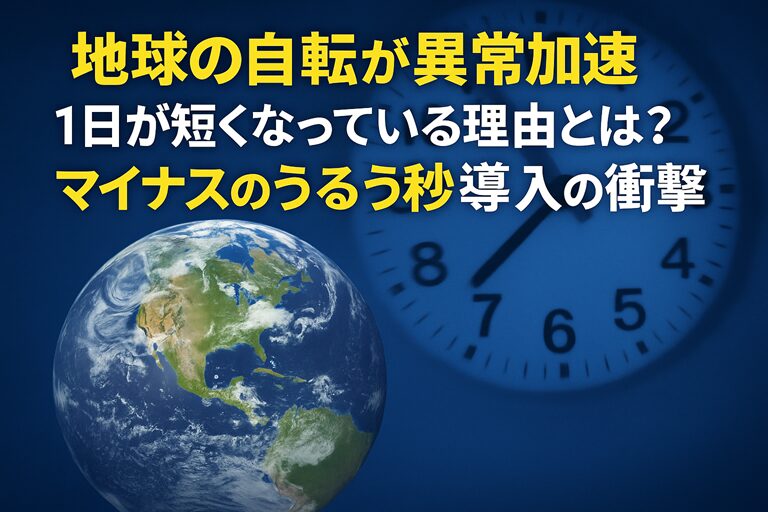目次
- 1 Earth’s Rotation Accelerates: Negative Leap Second Looms
- 1.1 The Truth About Earth’s Rotation Revealed by Atomic Clocks
- 1.2 Record-Breaking Shortest Days Continue in Unprecedented Situation
- 1.3 Complex Mechanisms Behind Earth’s Changing Rotation Speed
- 1.3.1 1. Lunar Gravity and Tidal Friction – The Main Cause of Long-term Deceleration
- 1.3.2 Effects of Tidal Friction
- 1.3.3 2. The “Boring Billion” and Thermal Tidal Torque
- 1.3.4 3. Earth’s Inner Core Motion – Key to Recent Acceleration?
- 1.3.5 4. Atmospheric and Oceanic Motion
- 1.3.6 Atmospheric and Oceanic Influences
- 1.3.7 5. Changes in Earth’s Mass Distribution
- 1.4 Historical Changes in Earth’s Rotation Speed
- 1.5 Cutting-edge Observation Technology: VLBI and Space Geodesy
- 1.6 The Crisis of the First-Ever “Negative Leap Second”
- 1.7 International Movement Toward Leap Second Abolition
- 1.8 Short-term Effects of Lunar Position Changes
- 1.9 Human Activity’s Impact on Earth’s Rotation
- 1.10 Impact on Daily Life and the Concept of Time
- 1.11 Earth’s Internal Structure Reveals Rotation Mysteries
- 1.12 Conclusion: A Living Planet in Constant Change
Earth’s Rotation Accelerates: Negative Leap Second Looms
On July 10, 2025, Earth’s rotation speed reached this year’s fastest rate, with the day being 1.38 milliseconds shorter than the standard 24 hours, according to observations by the International Earth Rotation and Reference Systems Service (IERS) and the U.S. Naval Observatory. July 9 and July 22 also showed shortening trends, with August 5 predicted to be another historically short day.
Important: This phenomenon is not temporary. According to Nicholas Stamatakos, an astronomer at the U.S. Naval Observatory, the average length of a day has generally been shortening over the past decade, with the trend particularly pronounced over the past five years. Since 2020 alone, there have been 28 days when the day’s length was shorter than standard, which is “clearly an abnormal frequency.”
The Truth About Earth’s Rotation Revealed by Atomic Clocks
Earth’s rotation speed refers to the time it takes for Earth to complete one rotation on its axis, approximately 86,400 seconds (24 hours). However, this value is only an average, and it actually varies constantly.
Accurate measurement of a day’s length using atomic clocks began in 1955. Atomic clocks use the spectrum emitted by atoms as a frequency standard, based on the principle that the discrete energy intervals of atoms, molecules, or ions remain constant and unchanging.
Evolution of Atomic Clocks
- 1955: First cesium atomic clock developed in the UK (accuracy: about 1 part in 10 billion)
- 1967: The definition of a second changed to be based on cesium atomic transition frequency
- Present: Cesium atomic clock error has improved to about 1 part in 10 quadrillion
- Next Generation: Optical lattice clocks (proposed by Professor Hidetoshi Katori of the University of Tokyo in 2001) achieve 18-digit performance
Record-Breaking Shortest Days Continue in Unprecedented Situation
The recent acceleration of Earth’s rotation speed is truly an unprecedented phenomenon.
Recent Major Records
- July 19, 2020: 1.47 milliseconds shorter than usual (shortest record at that time)
- June 29, 2022: 1.59 milliseconds shorter (broke the record since atomic clock introduction)
- July 5, 2024: 1.66 milliseconds shorter (shortest day in history)
- July 10, 2025: 1.38 milliseconds shorter (shortest in 2025)
“2020 is considered the year with the fastest rotation since recording began in the 1970s. Despite the long-term tendency for rotation speed to slow due to lunar tidal forces, the rapid acceleration of rotation speed in recent years is historically abnormal, and scientists are perplexed, unable to identify clear causes.”
Complex Mechanisms Behind Earth’s Changing Rotation Speed
Earth’s rotation speed varies due to complex interactions between various Earth components (solid Earth, liquid core, oceans, atmosphere, ice sheets) and influences from external celestial bodies like the Moon and Sun. This is based on the law of conservation of Earth’s rotational angular momentum, where changes in mass distribution in one part cause compensatory changes in rotation speed in other parts.
1. Lunar Gravity and Tidal Friction – The Main Cause of Long-term Deceleration
The primary reason Earth’s rotation is gradually slowing is “tidal friction” caused by lunar gravity. Since Earth rotates faster than the Moon’s orbital speed, lunar gravity acts like a “brake” on Earth.
Effects of Tidal Friction
- Caused by friction between seawater and seafloor (oceanic tidal torque)
- Moon recedes from Earth by several centimeters annually
- After Moon formation: 24,000 km from Earth (currently about 380,000 km)
- Day length then: only 5 hours
- NASA reports deceleration of 2.3 milliseconds per century
- Prediction: days will be 25 hours long in 180 million years
2. The “Boring Billion” and Thermal Tidal Torque
Interestingly, during the period called the “Boring Billion” from about 2 billion to 1 billion years ago, research has revealed that oceanic tidal torque and thermal tidal torque balanced out, and Earth’s rotation period remained nearly fixed at about 19 hours.
Solar “thermal tidal torque” occurs when the Sun heats water vapor and ozone in the atmosphere, causing atmospheric expansion. While this effect is weaker than oceanic tidal torque, it works to accelerate Earth’s rotation.
3. Earth’s Inner Core Motion – Key to Recent Acceleration?
Latest Research: Earth’s liquid inner core has been slowing its rotation speed for nearly 50 years, and to conserve momentum, the solid parts above it (crust and mantle) may be accelerating in compensation.
Changes in Earth’s inner core motion are thought to affect rotation speed, and the coupling state between the fluid core and mantle also provides information about rotation speed variations. When the mantle and fluid core rotate around different axes, they can exert torque on each other through the core-mantle boundary.
Many scientists believe this “core lag” is not unrelated to the recent rapid rotation acceleration, but why the core’s speed is changing so suddenly now remains completely unexplained.
4. Atmospheric and Oceanic Motion
Earth’s atmosphere and oceans rotate with Earth, and changes in their motion affect Earth’s overall rotation speed.
Atmospheric and Oceanic Influences
- Jet Stream: When it weakens in summer, Earth’s rotation speeds up
- Weather Phenomena: El Niño and La Niña also have effects
- Angular Momentum Exchange: Momentum shared between atmosphere and solid Earth
- Correlation: Meteorological and geodetic observations match well
5. Changes in Earth’s Mass Distribution
When Earth’s mass distribution changes, similar to how figure skaters adjust rotation speed by pulling in or extending their arms during spins, Earth’s rotation speed also changes.
Climate Change Impact: Research from ETH Zurich shows that climate change has caused ice melting and groundwater movement, lengthening days by several milliseconds per century.
The 2011 Great East Japan Earthquake changed Earth’s mass distribution, shortening the day by 1.8 microseconds (0.0000018 seconds).
Historical Changes in Earth’s Rotation Speed
Earth’s rotation speed has changed dramatically since its birth.
Evolution of Earth’s Day Length
- 1-2 billion years ago: Days were only about 19 hours
- 430 million years ago: Fossilized coral analysis shows days were about 21 hours
- Dinosaur era (70 million years ago): Days were about 23.5 hours, years had 372 days
- Present: Days are 24 hours (precisely 23 hours 56 minutes 4 seconds)
- 180 million years from now (predicted): Days may be 25 hours
These historical records are estimated by examining growth lines in coral and shell fossils (similar to tree rings, showing daily and annual growth patterns). Shells form daily layers by secreting calcium carbonate, allowing inference of shorter days from thinner shell layers.
Cutting-edge Observation Technology: VLBI and Space Geodesy
While Earth rotation observations in the Meiji era used visual observations with optical telescopes, current mainstream technology uses space geodetic techniques represented by radio telescope interferometry (VLBI: Very Long Baseline Interferometry).
VLBI Technology Features
- Combines multiple radio telescopes to simultaneously receive radio waves from distant radio stars
- Precisely determines Earth’s orientation from phase differences in received radio waves at each station
- Accuracy of 1 milliarcsecond, two orders of magnitude better than optical observations
- Can determine Earth’s attitude extremely accurately
Other precision Earth measurement technologies include volume strain meters (measuring underground volume changes), tide gauges (measuring sea level changes), and seismic tomography (inferring convection from mantle heterogeneity).
The Crisis of the First-Ever “Negative Leap Second”
When Earth’s rotation speed diverges from atomic clock time (International Atomic Time: TAI), “leap seconds” are introduced to adjust the discrepancy. Since Earth’s rotation has tended to lag, a total of 27 “positive leap seconds” (adding 1 second) have been inserted since 1972.
Urgent Warning: Due to recent acceleration of Earth’s rotation, atomic clocks are now running ahead, creating the possibility of needing the world’s first “negative leap second” – deleting 1 second. This “negative leap second” could be introduced as early as 2029.
Implementation of Negative Leap Second:
In Japan time, 8:59:58 AM would be followed by 9:00:00 AM, with 8:59:59 AM being deleted. This is unprecedented and raises alarms about potentially catastrophic impacts on IT systems worldwide.
Past System Failures from Leap Seconds
Even past “positive leap second” adjustments have caused serious problems:
Actual Failures
- Linux & Reddit: System malfunctions occurred
- Aviation Industry: Boarding reservation systems crashed, affecting flights
- GPS: Accuracy degraded (depends on millisecond-precise timing)
- Financial Systems: Malfunctions (require second-precise time synchronization)
“Major IT companies like Meta, Google, and Amazon strongly oppose introducing ‘negative leap seconds.’ Many systems can handle adding time but aren’t designed to handle time deletion.”
International Movement Toward Leap Second Abolition
In response to these concerns, the General Conference on Weights and Measures (CGPM) adopted a policy in 2022 to stop leap second adjustments by 2035. This effectively means “abolishing leap seconds.”
Alternatives After Leap Second Abolition
- Expand the allowable time discrepancy range
- Consider introducing “leap minutes”
- Consider introducing “leap hours”
- Many other definitional changes and adjustments needed
Note that “leap years” adjust for discrepancies between Earth’s orbital period and the calendar, a completely different mechanism from “leap seconds.” Even if leap seconds are abolished, leap years will remain.
Short-term Effects of Lunar Position Changes
While lunar gravity causes long-term deceleration, from a short-term perspective, changes in the Moon’s position in its orbit also affect Earth’s rotation speed.
When the Moon is at its farthest from Earth’s equator (closest to the poles), the effect of lunar gravity on Earth’s rotation axis changes, causing rotation to speed up slightly. The predicted acceleration on July 9, July 22, and August 5, 2025, may be influenced by such lunar positioning.
Human Activity’s Impact on Earth’s Rotation
“Humans are having a greater impact on Earth than we realize, and naturally, humans bear great responsibility for Earth’s future.”
Glacier melting and groundwater movement due to climate change show that human activity indirectly affects Earth’s rotation speed. This demonstrates how changes in Earth’s rotation speed symbolize the magnitude of human impact on the entire Earth system.
Impact on Daily Life and the Concept of Time
Even if day length changes by milliseconds, we cannot perceive it in daily life. Since eye blinks take 100-400 milliseconds, a change of about 1 millisecond is imperceptible.
However, in fields like astronomy, communications, and precision engineering, such small errors can lead to significant problems, making this an important issue that cannot be ignored.
Long-term Impact: If discrepancies between Earth’s rotation and time are not adjusted, sunrise times could change in the distant future. Calculations suggest a 1-minute shift per century, 10 minutes per millennium, and a 1-hour shift in 6,000 years.
Earth’s Internal Structure Reveals Rotation Mysteries
Earth’s internal structure is essential for understanding its rotational behavior.
Earth’s Internal Features
- Moment of Inertia Coefficient: About 0.33 (reflects metallic core occupying half Earth’s radius)
- Mantle Viscosity: Upper mantle 10^20 Pa·s, lower mantle 10^22 Pa·s
- Seismic Anisotropy: Caused by iron crystal grain alignment in inner core
- Mantle Convection: Behaves as “fluid” on long timescales, causing plate motion
The mantle behaves as a “fluid” on long timescales, undergoing thermal convection. Surface motion of this mantle convection is plate tectonics. The phenomenon of “seismic anisotropy” is also observed, where seismic waves passing through the core vary greatly depending on direction.
Conclusion: A Living Planet in Constant Change
Changes in Earth’s rotation speed result from complex interactions among lunar gravity, atmospheric and oceanic motion, and Earth’s internal dynamics. While the long-term trend is deceleration due to lunar tidal forces, recent observations show temporary acceleration due to influences like inner core motion and atmospheric variations.
Conclusion: The rapid acceleration of rotation speed since 2020 has scientists perplexed, unable to identify clear causes. This abnormal acceleration has made the possibility of introducing the first-ever “negative leap second” increasingly real. This new challenge, arising from the precision of current technology, requires continuous observation and appropriate countermeasures.
Understanding variations in Earth’s rotation speed is important for elucidating deep Earth structure, climate change relationships, and the evolution of other solar system bodies.
Our Earth is a living planet in constant change, full of mysteries.









Leave a Reply